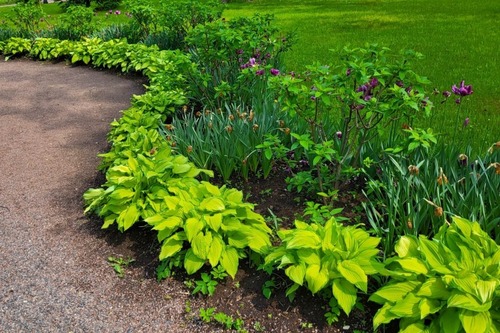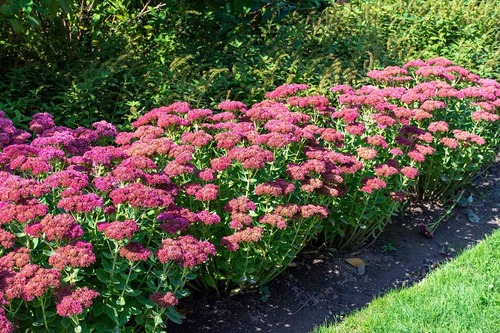A well-designed garden border can elevate the overall look of your outdoor space, adding structure, color, and texture. When selecting flowers for your garden borders, consider factors such as bloom time, sunlight requirements, and water needs to ensure your plants thrive. The seven beautiful flowers listed above – lavender, daylilies, hostas, salvia, geraniums, coreopsis, and sedum – offer a range of options to suit different climates and garden styles. By mixing and matching these plants, you can create a stunning, low-maintenance border that enhances your garden’s beauty throughout the growing season.
With thoughtful planning and the right combination of plants, your garden borders can be both functional and visually striking, transforming the edges of your outdoor space into a lush, colorful oasis.
1. Lavender

Lavender is one of the most popular choices for garden borders, not just because of its striking appearance, but also because of its lovely fragrance and versatility. Lavender’s fragrance not only adds a sensory experience to your garden but also helps repel pests like mosquitoes, making it a practical choice for garden borders.
The flower grows in neat clumps that form a well-defined edge. The tall, slender spikes of lavender flowers provide a beautiful contrast to the greenery, and the soft purple hue creates a serene, calming effect. The silvery-green foliage remains attractive even when the plant is not in bloom, ensuring your garden border looks great year-round.
It blooms from late spring through summer, and some varieties even bloom a second time in late summer or early fall. It thrives in full sun and well-drained soil. It’s drought-tolerant and low-maintenance, making it ideal for busy gardeners. It pairs well with other drought-tolerant plants like rosemary, sage, and yarrow.
2. Daylilies

Daylilies are another excellent choice for garden borders due to their vibrant colors and hardy nature. These perennial flowers come in a wide variety of shades, including yellow, orange, red, and pink, providing a burst of color along the edges of your garden.
They have an attractive, fountain-like growth habit that naturally spills over, softening the look of garden edges. They are perfect for filling gaps between other plants and creating a lush, layered look. One of the key benefits of daylilies is their ability to thrive in various climates, making them a versatile option for many gardens.
They bloom from late spring to midsummer, with some varieties offering repeat blooms throughout the growing season. They thrive in full sun to partial shade and are quite adaptable to different soil conditions. Daylilies are drought-tolerant and relatively pest-free. Pair daylilies with ornamental grasses, coneflowers, or black-eyed Susans for a dynamic and colorful border.
3. Hostas

Hostas are renowned for their large, lush leaves and ability to thrive in shaded areas. While they are primarily grown for their foliage, some varieties produce delicate white or purple flowers that add an extra touch of beauty. They come in a range of sizes, from dwarf varieties perfect for small spaces to giant types that make a bold statement, offering plenty of options for different garden designs.
They create a bold, dramatic edge in garden borders, especially in areas with dappled or full shade. Their large leaves offer excellent contrast to finer-leaved plants, creating a striking visual effect.
They bloom in mid to late summer, though their flowers are usually. They prefer moist, well-drained soil and shade to partial shade. They are low-maintenance and easy to grow, though you may need to watch out for slugs and snails, which are attracted to their leaves. Pair hostas with ferns, astilbes, or impatiens to create a cohesive, textured garden border.
4. Salvia

Salvia, also known as sage, is a stunning perennial that brings vertical interest and a pop of color to garden borders. With its tall, spiky blooms in shades of purple, blue, pink, and white, salvia is a favorite among pollinators like bees, butterflies, and hummingbirds.
In addition to its aesthetic appeal, salvia is also a useful herb in the garden, making it a practical and beautiful choice for garden borders. Most varieties of salvia bloom from late spring to fall, offering long-lasting color throughout the growing season. Salvia’s upright growth habit makes it ideal for adding height and structure to garden edges. Its long-lasting blooms create a vibrant and dynamic border that attracts beneficial insects.
Salvia likes full sun and well-drained soil. It’s drought-tolerant once established, and regular deadheading encourages continuous blooming. It pairs well with roses, coneflowers, and sedums, adding vertical interest to a mixed border.
5. Geraniums

Geraniums are classic garden favorites known for their bright, cheerful flowers and mounding growth habit. These versatile plants work beautifully in both formal and informal garden designs. They grow in neat, rounded mounds that help define garden edges. Their colorful flowers, which come in shades of red, pink, white, and purple, provide a burst of vibrant color that lasts for much of the growing season.
They are also relatively pest-resistant and easy to care for, making them a reliable choice for gardeners looking to create low-maintenance yet attractive borders. Depending on the variety, geraniums can bloom from spring through fall, offering nearly continuous color.
They grow well in full sun but can tolerate some light shade. They thrive in well-drained soil and benefit from regular watering and deadheading to prolong blooming. They complement a wide range of plants, including marigolds, petunias, and verbena.
6. Coreopsis

Also known as tickseed, coreopsis is a hardy perennial that produces an abundance of daisy-like flowers in shades of yellow, orange, and red. These cheerful flowers bring a bright, sunny look to garden borders. It has a compact, bushy growth habit that makes it perfect for creating a dense, colorful edge. Its long blooming period ensures your garden borders stay vibrant for much of the growing season.
It blooms from early summer to late fall, providing months of continuous color. In addition to its aesthetic appeal, coreopsis is also highly attractive to pollinators, making it a valuable addition to any garden that supports biodiversity.
This plant thrives in full sun and well-drained soil. It is drought-tolerant once established and requires little maintenance beyond occasional deadheading. It pairs beautifully with other sun-loving perennials like rudbeckia, echinacea, and gaillardia.
7. Sedum

Sedum, also known as stonecrop, is a tough, drought-tolerant perennial that is perfect for garden borders. With its succulent leaves and clusters of star-shaped flowers, sedum adds texture and interest to the garden. The structural quality of sedum, combined with its ability to thrive in challenging conditions, makes it a standout choice for gardeners looking to create a durable, low-maintenance border
Sedum typically blooms in late summer to fall, with some varieties offering striking fall color. Sedum’s low, spreading growth habit makes it ideal for creating a ground-hugging edge in garden borders. Its fleshy leaves come in various shades of green, red, and blue, offering year-round visual interest.
It grows better in full sun and well-drained, even rocky, soil. It requires minimal water once established, making it an excellent choice for xeriscaping or low-maintenance gardens. It works well with ornamental grasses, asters, and echinacea for a border that transitions beautifully from summer into fall.